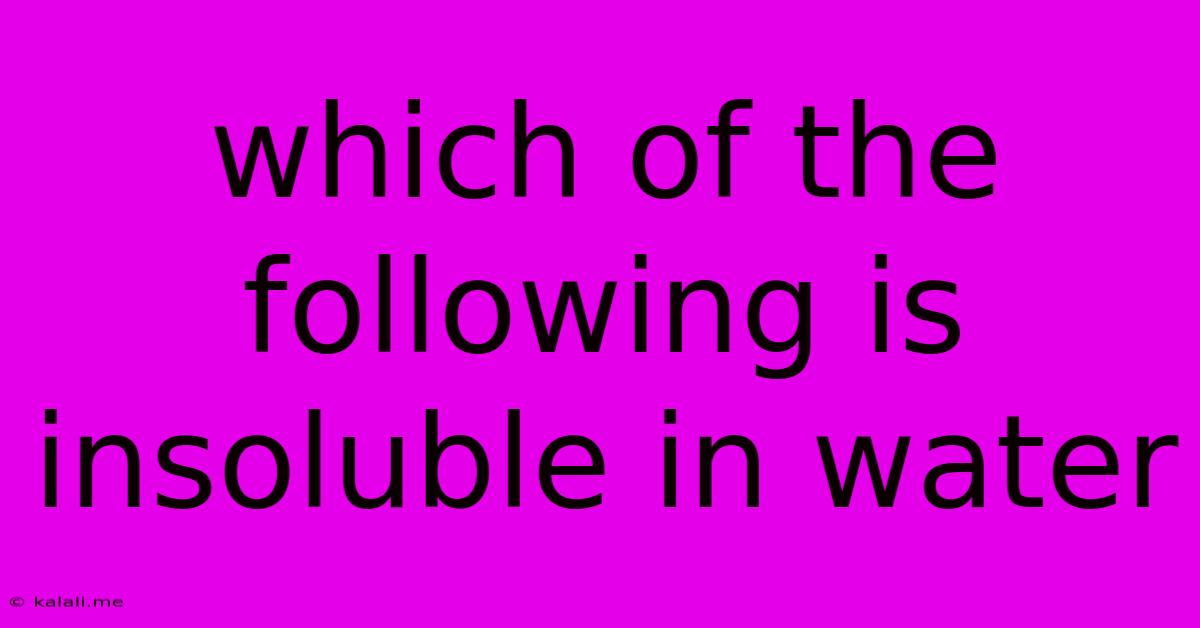Which Of The Following Is Insoluble In Water
Kalali
Jun 12, 2025 · 2 min read

Table of Contents
Which of the Following is Insoluble in Water? Understanding Solubility
This article explores the concept of solubility and helps you determine which substances are insoluble in water. We'll delve into the reasons behind solubility, providing you with a solid understanding of this important chemistry concept. Understanding solubility is crucial in various fields, from everyday life to complex scientific applications.
What is Solubility?
Solubility refers to the ability of a substance (the solute) to dissolve in a solvent (usually water). When a substance dissolves, its particles disperse uniformly throughout the solvent, forming a homogeneous solution. The extent to which a substance dissolves is expressed as its solubility, often measured in grams of solute per liter of solvent (g/L) at a specific temperature.
Factors Affecting Solubility
Several factors influence the solubility of a substance:
-
Polarity: "Like dissolves like" is a fundamental rule. Polar substances (those with uneven charge distribution) tend to dissolve in polar solvents like water, while nonpolar substances (even charge distribution) dissolve in nonpolar solvents. Water is a highly polar solvent.
-
Temperature: The solubility of most solids in water increases with increasing temperature. However, the solubility of gases in water generally decreases with increasing temperature.
-
Pressure: Pressure significantly affects the solubility of gases in liquids. Increased pressure increases the solubility of gases.
Identifying Insoluble Substances
To determine if a substance is insoluble in water, you need to consider its chemical properties and structure. Generally, nonpolar substances and ionic compounds with large, complex ions are often insoluble in water. Examples include:
-
Many organic compounds: These often have long hydrocarbon chains, making them nonpolar and thus insoluble in water. Examples include oils and fats.
-
Ionic compounds with low charge density: While many ionic compounds dissolve in water, those with large, bulky ions often have weaker interactions with water molecules, leading to lower solubility.
-
Some metal hydroxides and sulfides: These compounds often have very low solubility in water.
-
Many metal carbonates and phosphates: These are often sparingly soluble or practically insoluble in water.
Examples of Insoluble Substances:
Without a specific list of substances "following," we can provide general examples:
- Sand (silicon dioxide): A highly nonpolar network solid, it doesn't interact with water molecules.
- Oil: Nonpolar hydrocarbons do not dissolve in polar water.
- Most plastics (polymers): These large molecules are generally nonpolar.
- Calcium carbonate (CaCO₃): While slightly soluble, it's considered sparingly soluble and precipitates easily.
- Silver chloride (AgCl): A classic example of a low-solubility ionic compound.
Conclusion:
Determining whether a substance is insoluble in water requires understanding its chemical properties, specifically its polarity and the nature of its interactions with water molecules. While some substances are completely insoluble, many exhibit varying degrees of solubility, making it essential to consider the context and conditions. Understanding these principles is vital for many scientific and practical applications.
Latest Posts
Latest Posts
-
2 Sample T Test Or Z Test
Jun 13, 2025
-
Which Sea Separates Europe From Africa
Jun 13, 2025
-
Which Of The Following Is True About A Firewall
Jun 13, 2025
-
Difference Between Animal And Plant Mitosis
Jun 13, 2025
-
What Is The Multiples Of 13
Jun 13, 2025
Related Post
Thank you for visiting our website which covers about Which Of The Following Is Insoluble In Water . We hope the information provided has been useful to you. Feel free to contact us if you have any questions or need further assistance. See you next time and don't miss to bookmark.